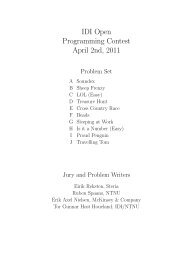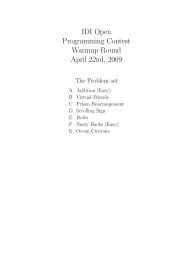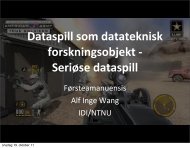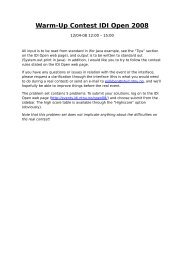Reverse-engineering of individual and inter-personal work practices
Reverse-engineering of individual and inter-personal work practices
Reverse-engineering of individual and inter-personal work practices
- No tags were found...
Create successful ePaper yourself
Turn your PDF publications into a flip-book with our unique Google optimized e-Paper software.
knowledge <strong>of</strong> organization’s implementation issues is useful not only for IS developersbut also for organization analysts <strong>and</strong> managers. Due to their focus on organization’s design,current modeling approaches provide process-centered, role-based models that arenot able to capture <strong>work</strong> <strong>practices</strong>. Moreover, these approaches regard organizations asstatic, mechanistic <strong>and</strong> deterministic systems that not reflect the nature <strong>of</strong> human behavior.We need a semi-formal modeling frame<strong>work</strong> that captures the complexity, situated<strong>and</strong> dynamic behavior <strong>of</strong> people at <strong>work</strong>.In this paper, we describe an approach to discover <strong>and</strong> model <strong>individual</strong> <strong>and</strong> <strong>inter</strong><strong>personal</strong><strong>work</strong> <strong>practices</strong>. The proposed approach is based on a conceptual frame<strong>work</strong>that regards organizations as complex, adaptive systems that result from the <strong>inter</strong>actionamong its agents [4]. This frame<strong>work</strong> defines an architecture <strong>and</strong> ontology <strong>of</strong> organizationsagents consistent with that view. The concept <strong>of</strong> context is an essential component<strong>of</strong> this “architected” ontology [5]. Drawing on this ontology, we propose an approach todiscover <strong>and</strong> depict context-based representations <strong>of</strong> <strong>work</strong> <strong>practices</strong> from repositories <strong>of</strong>executed actions. More specifically, we capture subject actions in terms <strong>of</strong> triples, that identify the human actor, action type <strong>and</strong> resources used. Weuse contexts to group together action streams <strong>and</strong> associated resources <strong>of</strong> each <strong>individual</strong>.These groupings are thereafter regarded as “units” to identify <strong>individual</strong> <strong>and</strong> <strong>inter</strong><strong>personal</strong><strong>work</strong> patterns. The representations obtained are intended mainly for organizationalanalysis ends. Hence, rather than supporting an <strong>engineering</strong> process, we aim at facilitatinga “reverse-<strong>engineering</strong>” <strong>of</strong> <strong>work</strong> <strong>practices</strong>. The remaining <strong>of</strong> this paper is structuredas follows; Sections 2 <strong>and</strong> 3 summarize related <strong>work</strong> on enterprise <strong>and</strong> contextmodeling. Section 4 summarizes the underlying model <strong>of</strong> the frame<strong>work</strong>. Section 5 describesthe acquisition approach proposed <strong>and</strong> illustrates it with examples from casestudies. Section 6 briefly summarizes results on automatic discovery <strong>of</strong> <strong>personal</strong> contexts<strong>and</strong> Section 7 gives our conclusions <strong>and</strong> future directions.2 Enterprise modelingEnterprise modeling approaches coming from IS/AI fields models are commonly referredas Enterprise Architectures or Enterprise Ontologies. One distinctive feature <strong>of</strong>Enterprise Architectures is enabling to model organizations from different perspectivesor viewpoints <strong>and</strong> to provide means to assess the alignment between them. EnterpriseArchitectures are process-driven <strong>and</strong> regard agents as simple resources <strong>of</strong> business process.In AI, two well known enterprise ontologies are the Enterprise Ontology (EO) proposedby Uschold [2] <strong>and</strong> the ontologies developed within the TOVE project [12]. SeveralMulti-Agent Systems (MAS) development frame<strong>work</strong>s have proposed meta-modelscomprising several social <strong>and</strong> organizational concepts, encompassing single-agent, twoagent,group <strong>and</strong> organizational level concepts [11]. AI Enterprise ontologies <strong>and</strong> MASmeta-models provide an organizational perspective with richer sets <strong>of</strong> agent-related concepts.However these models do not fully reflect the complexity <strong>and</strong> autonomy <strong>of</strong> organizationalagents.







